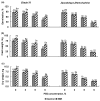A Comparative Analysis of the Effect of 24-Epibrassinolide on the Tolerance of Wheat Cultivars with Different Drought Adaptation Strategies Under Water Deficit Conditions
- PMID: 40265790
- PMCID: PMC11944902
- DOI: 10.3390/plants14060869
A Comparative Analysis of the Effect of 24-Epibrassinolide on the Tolerance of Wheat Cultivars with Different Drought Adaptation Strategies Under Water Deficit Conditions
Abstract
Drought is a serious environmental challenge that reduces the productivity of valuable crops, including wheat. Brassinosteroids (BRs) is a group of phytohormones that have been used to enhance wheat drought tolerance. Wheat cultivars with different adaptation strategies could have their own specific drought tolerance mechanisms, and could react differently to treatment with growth regulators. In this work, the effect of seed pretreatment with 0.4 µM 24-epibrassinolide (EBR) was investigated in two wheat (Triticum aestivum L.) cultivars contrasting in drought behavior, tolerant Ekada 70 (cv. E70) and sensitive Zauralskaya Zhemchuzhina (cv. ZZh), in early ontogenesis under dehydration (PEG-6000) or soil drought conditions. EBR pretreatment mitigated the stress-induced inhibition of seedling emergence and growth, as well as membrane damage in cv.E70 but not in ZZh. An enzyme-linked immunosorbent assay (ELISA) revealed substantial changes in hormonal balance associated with ABA accumulation and a drop in the levels of IAA and cytokinins (CKs) in drought-subjected seedlings of both cultivars, especially ZZh. EBR-pretreatment reduced drought-induced hormone imbalance in cv. E70, while it did not have the same effect on ZZh. EBR-induced changes in the content of wheat germ agglutinin (WGA) belonging to the protective proteins in E70 seedlings suggest its contribution to EBR-dependent adaptive responses. The absence of a detectable protective effect of EBR on the ZZh cultivar may be associated with its insensitivity to pre-sowing EBR treatment.
Keywords: 24-epibrassinolide; drought adaptation; phytohormones; wheat (Triticum aestivum L.) cultivars; wheat germ agglutinin.
Conflict of interest statement
The authors declare no conflicts of interest.
Figures




References
-
- Kruglova N.N., Zinatullina A.E. Some methodological approaches to the identification of heat-resistant genotypes of crop plants (by the example of cereals) Biol. Bull. Rev. 2023;13:371–381. doi: 10.1134/S2079086423040060. - DOI
LinkOut - more resources
Full Text Sources

